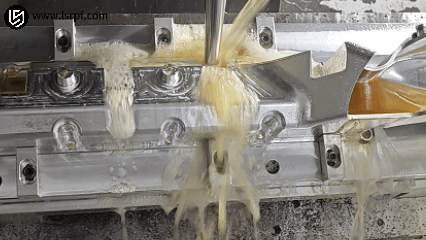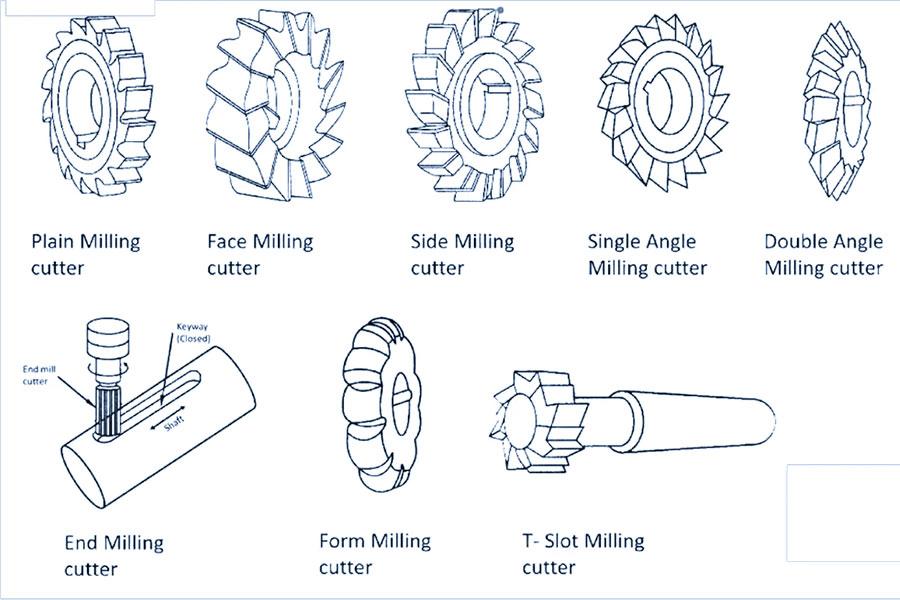In modern manufacturing,CNC milling technology has become an indispensable processing methoddue to its high precision, high efficiency and high flexibility. CNC milling receives pre-programmed instructions through CNC machine tools and automatically controls the movement trajectory of the tool on the workpiece to achieve precise processing of complex parts. The Longsheng team will introduce you to the varioustypes of CNC millingin detail and discuss their characteristics and advantages in practical applications.
What is CNC milling?
CNC milling is a process that usesCNC machine toolsand computer control systems that are independent of human operation to remove material by moving rotating cutting tools relative to the workpiece to produce custom-designed parts or products. The basic principle is that the processor formulates the processing technology, selects the processing parameters, and inputs the compiled processing program into the CNC device. The servo motor controls the relative movement of the tool and the workpiece according to a certain trajectory, thereby realizing the cutting of the workpiece and automatic processing.

How Does CNC Milling Work?
TheCNC milling processcan be clearly divided into the following steps, each of which includes key operations:
| Process Flow | Key Operations |
| Design product drawings | Based to the product requirements using computer-aided design software (such as CAD). The dimensions and positions of the holes and grooves to be milling are clearly marked on the drawings. |
| Select the cutting tool | Select the appropriate milling cutter head according to the material and processing requirements of the product. For example, for the aluminum alloy material, the rigid carbide thread drilling and milling cutter can be selected. |
| Design the cutting path | Determine the cutting path and processing sequence according to the product drawings. This helps to optimize the processing process and improve the processing efficiency. |
| Set the machine tool parameters | Set the appropriate cutting speed, feed speed and cutting depth according to the material hardness and product requirements. For example, for aluminum alloy materials, the milling cutter speed can be set to 2,000 r/min, the cutting speed is 314m / min, the milling feed is 0.06mm / tooth, etc. |
| Install the workpiece | Attach the workpiece to be processed on the milling machine to ensure stability and positioning accuracy. This can be achieved by using fixtures or other tooling equipment. |
| Processing operation | After the workpiece is stable and the machine parameters are set correctly, start the machine and start milling. In the processing process, it is necessary to closely monitor the cutting situation and timely adjust the cutting parameters to ensure the processing quality. |
| Processing inspection | After milling, inspect the finish surface. This includes dimensional inspection, surface quality inspection, etc. to ensure that the processing quality meets the requirements. |
| Post processing | If a problem is found in the processing inspection, improve or grind accordingly until the requirements are met. |
What are the 5 common types of CNC milling machines?
The five commontypes of CNC milling machines are vertical CNC millingmachines, horizontal CNC milling machines,5-axis CNC milling machines, 3+2-axis CNC milling machines, and CNC milling and turning centers. Below we will introduce the characteristics and applications of these five milling machines in detail.
Vertical CNC Milling Machines
- Features:The spindle of the verticalCNC milling machineis arranged vertically, and the workbench is horizontal, rectangular, and large in area. This layout makes the workpiece easy to install and the operation easy to observe. Vertical CNC milling machines have the characteristics of high precision, high speed, high efficiency and high quality, and are widely used in mold processing, parts processing and other fields.
- Typical applications:mold manufacturing, metal parts processing, and the production of various aircraft parts in the aerospace field, such as car seats, consoles, landing gear, nose, and tail components, etc.
Horizontal CNC Milling Machines
- Features:The spindle of the horizontal CNC milling machine is parallel to the workbench. Its structure is relatively complex, but it has good rigidity and stability and can withstand large cutting forces. In addition, the horizontal CNC milling machine has a high spindle power and a wide speed range, making it suitable for heavy cutting and large-volume metal cutting.
- Typical applications:Mainly used for processing high-strength materials, such as large molds, automobile parts, etc. In the aerospace and defense industry, horizontal CNC milling machines are also commonly used to process key components such as aircraft landing gear and engine blades.

5-Axis CNC Milling Machines
- Features:The 5-axis CNC milling machine has five motion axes, including three linear motion axes (X, Y, Z) and two rotary axes (A, B, or C). This configuration allows the tool to process the workpiece from multiple angles, greatly improving the flexibility and accuracy of processing.
- Typical applications:5-axis CNC milling machines are widely used in aerospace, medical, mold manufacturing and other fields. In the aerospace field, it is used to process complex parts such as aircraft engine blades and fuselage structural parts; in the medical field, it is used to manufacture high-precision, high-complexity medical devices and implants.
3+2 Axis CNC Milling Machines
- Features:3+2-axis CNC milling machine combines 3 linear motion axes and 2 rotary axes, but these two rotary axes are usually used to fix the angle of the workpiece rather than processing at the same time. This configuration enables the machine tool to perform fixed processing on the workpiece at multiple angles, and is suitable for parts with multi-faceted processing and specific angle requirements.
- Typical applications:Mainly used for processing parts that require multi-sided processing and specific angle requirements, such as automotive parts, mold parts, etc.
CNC Milling Turning Centers
- Features:CNC milling and turning center is a composite processing machine tool that combines milling and turning processes to achieve multi-process composite processing. This kind of machine tool has an automatic tool changing system, which can automatically select and replace tools as needed, thus greatly improving processing efficiency and accuracy.
- Typical applications:Mainly used for processing complex parts such as shaft parts, threads, sleeve parts, etc. In fields such as automotive parts manufacturing and aerospace, CNC milling and turning centers play an important role.
What are the Different Types of Milling Operations?
CNC milling is an efficient metal processing method that uses computer-controlled machine tools and rotating milling cutters to precisely remove material. Although the specifictypes of CNC millingmay vary depending on different classification standards and actual application scenarios, the following are some common CNC milling types:
- Face Milling:This is the most commonly used type of milling and is used to mill planes parallel to the tool face. The milling cutter is often installed on the spindle, and the completion of face milling can be done with a tool with a certain diameter, so that the processing of the workpiece can be completed in one stroke, and the milling cutter of the same diameter that requires several strokes to complete the machining of the workpiece can be used.
- End milling:It is mainly used for processing step surfaces of about 90°. This type of milling is somewhat similar to face milling, but the angle of the circumferential cutting edge plays a decisive role. This tool can only be used if a part of the workpiece to be machined is a 90° shoulder. The side of the tool (entering angle) is parallel to the axis of rotation.
- Copy milling:This milling method is used to machine free-form or curved surfaces, where the tool path follows the contour of the workpiece.
- Step milling:Also known as shoulder milling or end milling, it is mainly used to process 90° shoulders or step surfaces. The flanks of the tool (the entering angle) are parallel to the axis of rotation.
- Contour milling:For machining the external or internal contours of a workpiece, the tool path is precisely planned according to the shape of the workpiece.
- Plunge milling:Plunge milling is an effective processing method in deeper cavity processing. It uses a long, thin tool that is inserted vertically into the workpiece to cut.
- Helical milling:Thistype of milling uses a helical path to cutand is often used to machine cylindrical or conical surfaces.
- Point milling: Mainly used to process small holes or small areas of complex shapes, achieving precise cutting through tiny movements of the tool.
- Slot milling:used to process slots of various shapes and sizes, such as T-slots, dovetail slots, etc.
- Drilling and milling: Although drilling is usually considered a separate processing method, it can also be drilled using a milling cutter on aCNC milling machine.
- Cavity milling:used to process complex internal cavities, such as molds, shells, etc. This type of milling requires precise tool path planning and appropriate tool selection.
- Rough milling and fine milling:Rough milling mainly removes a large amount of material, using large feeds and cutting depths; while fine milling focuses on the surface quality of the workpiece, using small cutting depths and appropriate tool secondary cutting edge shapes.

CNC Milling Materials: What Can Be Milled?
As a high-tech processing method for precision hardware parts, CNC milling can use many types of materials. Here are some common CNC milling materials:
Aluminium
Aluminum is a widely used metal materialwith light weight, high strength, easy processing and good corrosion resistance. Aluminum has a density of about 2.7g / cm³, only a third of copper and steel, but the strength is very high. Moreover, aluminum has excellent electrical conductivity and thermal conductivity, so that it is widely used in electric power, electronics, heat exchanger and other fields.
There are many kinds of common aluminum alloy and its common aluminum alloy, such as 2024,5052,6061,7075 and so on.2024 aluminum alloy high strength, good fatigue resistance, often used in aircraft structure; 5052 aluminum alloy good corrosion resistance, often used in the manufacture of oil tank, pipe, etc.; 6061 aluminum alloy welding, processing, often used in the manufacture of body structure; 7075 aluminum alloy high strength, often used in manufacturing high strength parts.
Steel
A variety of steel alloys can be used for CNC machining. Steel alloy can be selected if parts require higher formability and greater weldability, such as gears, shafts, or certain high-stress applications. Stainless steel, low carbon steel, alloy steel and tool steel are the main types of CNC steel. Stainless steel is highly recommended when parts require high strength, high ductility, excellent wear resistance and corrosion resistance. In addition, stainless steel has good workability and is easy to weld and polish. Low carbon steel (low carbon steel) is appropriate when the cost plays an important role and the application is for general use. Carbon steel also has good weldability and corrosion resistance. Alloy steel and TiSCO are the exceptions when you consider higher hardness, greater stiffness, and heat resistance.
Copper
Copper is a popular CNC machining materialwith unique properties, including excellent electrical and thermal conductivity. Because to its excellent electrical conductivity, product engineers consider copper and its alloys ideal for electrical and electronic components. Similarly, copper alloy is the perfect CNC material for jewelry production because of its excellent beauty. Wire, jewelry production, and magnetic equipment are typical applications of copper.
Brass, bronze and copper are indispensable forCNC machining materials. Brass and bronze are common copper alloys with unique properties. Brass is composed of copper and zinc. It is a very soft metal that can be processed without lubrication. It has excellent electrical conductivity, corrosion resistance and workability. Manufacturers often use brass for applications that do not require high strength, such as the manufacture of low-strength fasteners, electrical equipment, consumer goods, and piping equipment.
Bronze, on the other hand, consists of copper, tin, and other composite elements. It is strong and durable, and has a strong corrosion resistance. Bronze has excellent workability, which is perfect for machining precision parts such as bearings and gears. In addition, the addition of aluminum and phosphorus can improve the impact resistance, toughness, and strength of bronze.
Titanium
This CNC metal is very strong and light in weight, with an excellent strength to weight ratio. The corrosion resistance, thermal conductivity and biocompatibility of titanium make it compatible with CNC machining in the biomedical industry. Titanium is compatible with welding, passivation and anodizing processes for enhanced appearance and protection. Although titanium has poor electrical conductivity, it has good thermal conductivity and high melting point.
In addition, titanium is well suited for manufacturing high-performance mechanical parts in the medical, military, aerospace and automotive industries. More noteworthy, titanium is suitable for manufacturing cutting tools forCNC machine tools.
Plastics
Plastics are also very popular option for CNC machiningbecause of its wide choices, relatively lower price, and significantly faster machining time needed. According to different characteristics and uses, plastics are divided into many species, such as POM, ABS, PVC, etc. Plastics are characterized by small density, high strength and strong plasticity, and are widely used in electronics, automobile manufacturing, environmental protection and other fields.
Ceramic
Ceramics is another common non-metallic material, with the advantages of high strength, high hardness, high wear resistance, corrosion resistance and high temperature resistance. Among them, alumina ceramics, silicon nitride ceramics, silicon carbide ceramics and other types are common in industrial manufacturing, electronics, aerospace and other fields.
What factors affect the cost of CNC milling?
The cost of CNC milling is a complex issue because it is affected by other cost factors such as machine tool cost, tool cost, material cost, labor cost, electricity cost, etc.
| Factor | Description |
| Machine tool cost | The prices of different types of CNC milling machines vary greatly. For example, the price ranges of low-end, mid-range and high-end CNC milling machines are respectively 100,000 yuan to 300,000 yuan, 300,000 yuan to 800,000 yuan and 800,000 yuan to 200,000 yuan. Between ten thousand yuan. The performance, accuracy and stability of the machine tool will also affect its price and cost of use. |
| Tool Cost | The quality and type of tool have a significant impact on machining costs. The hardness, wear resistance and service life of the tool will all affect its cost. For free-cut parts with general precision, the ratio of tool cost to machine tool cost is about 1:9. |
| Material cost | The hardness and toughness of the workpiece material affects depth of cut and labor hours. There are also additional costs associated with the procurement, transportation and storage of materials. |
| Labor cost | Operator salary, training and benefits are important components of labor costs. Programming, debugging, clamping and disassembly during the machining process also require manual participation. |
| Electricity cost | CNC milling machines consume a lot of electricity during operation. Electricity costs will vary based on local electricity prices and the power consumption of the machine tool. |
| Other | including the cost of auxiliary materials such as coolant, cutting fluid, lubricating oil, etc. Equipment maintenance and upkeep costs are also a part that cannot be ignored. |
FAQs
1.How many types of CNC milling machines are there?
There are many types of CNC milling machines, which are mainly classified according to their functions, structures, processing range and other factors. Common CNC milling machine types include: End mill: An end mill is a general-purpose milling tool that is particularly suitable for machining flat surfaces and grooves. Face milling cutter: Face milling cutter is mainly used for cutting large-area planes. It has a large number of cutting edges, high cutting efficiency, and can maintain a high surface finish. Ball nose milling cutter: Ball nose milling cutter is suitable for processing three-dimensional curved surfaces and complex curved surface contours due to its unique spherical cutting edge. Slot Drills and Roughing End Mills: Slot drills are primarily used for drilling and grooving, while roughing end mills are particularly useful for removing large volumes of material quickly and efficiently. Flying cutters and sleeve milling cutters: Both flying cutters and sleeve milling cutters are suitable for machining large surface areas. Flying cutters are known for their high-speed, efficient cutting performance, while sleeve milling cutters can more flexibly adapt to the processing needs of various shapes.
2.What are the different types of CNC milling bits?
There are many types of CNC milling drill bits to choose from depending on the processing needs and material properties. Common CNC milling drill bit types include: Twist drill: widely used in drilling processing, with simple structure and easy to manufacture and maintain. Hole reamer: used to enlarge the size of existing holes to ensure the accuracy and surface quality of the holes. Boring tool: mainly used for finishing holes, which can maintain high processing accuracy and surface finish.
3.What are the three types of milling?
According to different processing methods and strategies, milling processing can be mainly divided into: Plane milling: mainly used for processing planes or plane profiles. Contour milling: Processing according to the contour of the part, suitable for processing complex curved surfaces. Copy milling: Processing based on a model or template, which can copy the same shape as the model or template.
4.What type of machining process is CNC milling?
CNC milling is a milling process based on CNC technology. It uses the CNC system to control the movement of the tool in the three axes of X, Y, and Z, as well as the rotation of possible rotation axes (such as A-axis, B-axis, etc.) to achieve precise processing of parts. CNC milling is widely used in mechanical equipment manufacturing, mold processing, aerospace and other fields. It can complete the processing of complex curved surfaces and angles that are difficult to perform with ordinary milling.
Summary
There are manytypes of CNC milling, such as face milling, end milling, copy milling, step milling,contour milling, plunge milling,helical milling,slot milling,Cavity milling,etc. Each type has its own unique processing characteristics and scope of application. In practical applications, it is necessary to comprehensively consider factors such as the shape, size, and material properties of the workpiece to select the appropriate processing type and cutting parameters. With the continuous development and improvement of CNC technology, the processing capabilities and application scope of CNC milling will continue to expand, making greater contributions to the development of the manufacturing industry.
Disclaimer
The content on this page is for reference only.Longshengdoes not make any express or implied representation or warranty as to the accuracy, completeness or validity of the information. No performance parameters, geometric tolerances, specific design features, material quality and type or workmanship should be inferred as to what a third party supplier or manufacturer will deliver through the Longsheng Network. It is the responsibility of the buyerseeking a quote for partsto determine the specific requirements for those parts.Pleasecontact usfor moreinformation.
LS Team
This article was written by multiple Longsheng contributors. Longsheng is a leading resource in the manufacturing sector, withCNC machining,sheet metal fabrication,3D printing,injection molding,metal stamping, and more.





